
Alstroemeria, commonly called the Peruvian lily or lily of the Incas, is a genus of flowering plants in the family Alstroemeriaceae. They are all native to South America, although some have become naturalized in the United States, Mexico, Australia, New Zealand, Madeira and the Canary Islands. Almost all of the species are restricted to one of two distinct centers of diversity; one in central Chile, the other in eastern Brazil. Species of Alstroemeria from Chile are winter-growing plants, while those of Brazil are summer growing. All are long-lived perennials except A. graminea, a diminutive annual from the Atacama Desert of Chile.

Erica cinerea, the bell heather, is a species of flowering plant in the heath family Ericaceae, native to western and central Europe.

Lavandula angustifolia, formerly L. officinalis, is a flowering plant in the family Lamiaceae, native to the Mediterranean. Its common names include lavender, true lavender and English lavender ; also garden lavender, common lavender and narrow-leaved lavender.

Paeonia lactiflora is a species of herbaceous perennial flowering plant in the family Paeoniaceae, native to central and eastern Asia from eastern Tibet across northern China to eastern Siberia.

Thymus vulgaris is a species of flowering plant in the mint family Lamiaceae, native to southern Europe from the western Mediterranean to southern Italy. Growing to 15–30 cm (6–12 in) tall by 40 cm (16 in) wide, it is a bushy, woody-based evergreen subshrub with small, highly aromatic, grey-green leaves and clusters of purple or pink flowers in early summer.
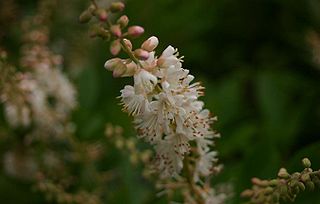
Clethra alnifolia, the coastal sweetpepperbush or summer sweet, is a species of flowering plant in the genus Clethra of the family Clethraceae, native to eastern North America from southern Nova Scotia and Maine south to northern Florida, and west to eastern Texas. It is a deciduous shrub which grows in wetlands, bogs and woodland streams.

Viburnum plicatum is a species of flowering plant in the family Adoxaceae, native to mainland China, Korea, Japan, and Taiwan. The Latin specific epithet plicatum means “pleated”, referring to the texture of the leaves.

Symphyotrichum lateriflorum is a species of flowering plant in the aster family (Asteraceae). Commonly known as calico aster, starved aster, and white woodland aster, it is native to eastern and central North America. It is a perennial and herbaceous plant that may reach heights up to 120 centimeters and widths up to 30 centimeters.

Pachysandra terminalis, the Japanese pachysandra, carpet box or Japanese spurge, is a species of flowering plant in the boxwood family Buxaceae, native to Japan, Korea and China and introduced to eastern North America. It is a slow-growing, spreading evergreen perennial growing to 10 cm (4 in) tall by 60 cm (24 in) broad, with alternate, simple, glossy leaves, and creeping stems. The leaves may yellow in direct sunlight or in winter. When growing in a spreading mass of many plants, a dense cover is formed.

Ornithogalum nutans, known as drooping star-of-Bethlehem, is a species of flowering plant in the family Asparagaceae, native to Europe and South West Asia. It is a bulbous perennial growing to 20–60 cm (8–24 in) tall by 5 cm (2 in) wide, with strap-shaped leaves and green striped, pendent grey-white flowers in spring. It is cultivated, and has naturalized, outside its native range, for example in North America. It has become extremely invasive along the Chesapeake and Ohio Canal in Maryland. At least in North America, it is not as common as Ornithogalum umbellatum.
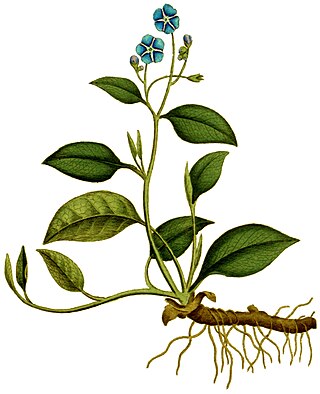
Omphalodes (navelwort) is a genus of flowering plants in the family Boraginaceae, widely distributed in the temperate Northern Hemisphere. In spring they produce blue or white flowers similar to forget-me-nots.
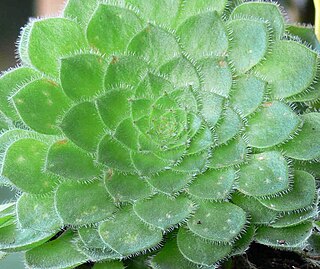
Aeonium tabuliforme, the flat-topped aeonium or saucer plant, is a species of succulent plant in the family Crassulaceae, native and endemic to Tenerife in the Canary Islands. It is low-growing, typically reaching about 5 cm high but up to 45 cm in diameter. It grows on moist, north-facing cliffs and ledges at low altitude. A mass of fleshy, hairy, bright green leaves in flat rosettes is produced on short unbranched stems, often on vertical surfaces. This species is short-lived and dies after flowering. Plants often take 3-4 years to flower, at which point they produce a tall raceme of yellow flowers.

Ranunculus aconitifolius, the aconite-leaf buttercup or bachelor's buttons, is a species of flowering plant in the buttercup family Ranunculaceae, native to central Europe. Growing to 60 cm (24 in) high by 40 cm (16 in) broad, this herbaceous perennial has slightly hairy palmate leaves up to 20 cm (8 in) long, and loose panicles of white, saucer-shaped flowers in spring.
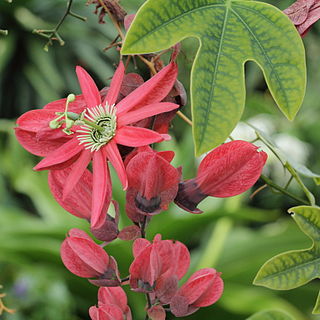
Passiflora racemosa, the red passion flower, is a species of flowering plant in the family Passifloraceae, native to Brazil. It is an evergreen climber growing to 5 m (16 ft), with simple or 3-lobed leaves to 10 cm (4 in) long, and vivid red flowers borne in summer. The flowers are 12 cm (5 in) in diameter, with purple and white coronas. They are followed by oblong green fruits.
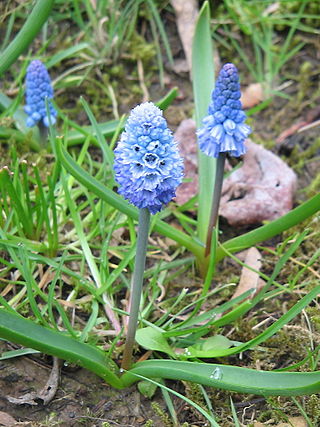
Pseudomuscari azureum, the azure grape hyacinth, is a species of flowering plant in the family Asparagaceae, native to Turkey. A bulbous perennial, it is grown in gardens for its spring flowers. The Latin specific epithet azureum means "bright blue", a reference to its flower colour.
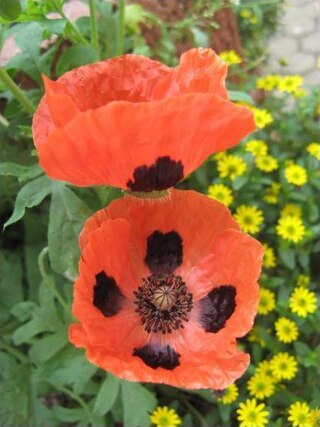
Papaver commutatum, the Caucasian scarlet poppy, is a species of flowering plant in the family Papaveraceae native to northern Turkey, northwestern Iran and the Caucasus. It is an erect annual growing to 45 cm (18 in) tall by 15 cm (6 in) wide, with hairy stalks and leaves. The flower is bowl-shaped and about 8 cm (3 in) in diameter, bright red with prominent black blotches at the bases of the petals, and is borne in early summer. The flowers are followed by spherical seed heads.

Heliopsis helianthoides is a species of flowering plant in the family Asteraceae, known by the common names rough oxeye, smooth oxeye and false sunflower. It is native to eastern and central North America from Saskatchewan east to Newfoundland and south as far as Texas, New Mexico, and Georgia.

Omphalodes cappadocica, the Cappadocian navelwort, is a species of flowering plant in the family Boraginaceae, native to woodland habitats in Turkey. It is an evergreen perennial growing to 25 cm (10 in) tall by 40 cm (16 in) wide, with slightly hairy, oval pointed leaves and loose terminal racemes of bright blue flowers with white eyes, similar to forget-me-nots, appearing in spring.
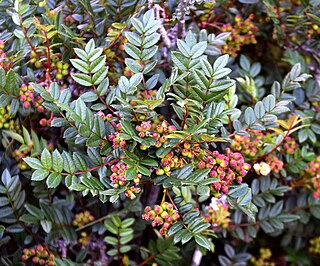
Sorbus reducta, the dwarf Chinese mountain ash, is a species of flowering plant in the family Rosaceae, native to western China (South West Sichuan and North West Yunnan}. Growing to 1.5 m tall by 2 m wide, it is a dense deciduous spreading shrub. Each leaf, 10 cm long, has up to 15 leaflets which turn to brilliant shades of red in the autumn. White flowers in spring are followed by red or pink, and then white berries in autumn.
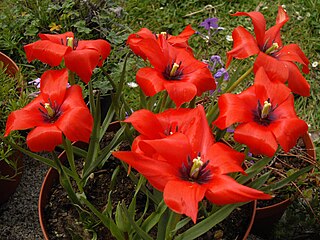
Tulipa linifolia, the flax-leaved tulip or Bokhara tulip, is a species of flowering plant in the tulip genus Tulipa, family Liliaceae, native to Tajikistan, Uzbekistan, northern Iran and Afghanistan. Growing to 20 cm (8 in) tall, it is a bulbous perennial with wavy red-margined sword-shaped leaves, and bowl-shaped red flowers in early to mid-spring. Each petal has blackish marks at the base.




















